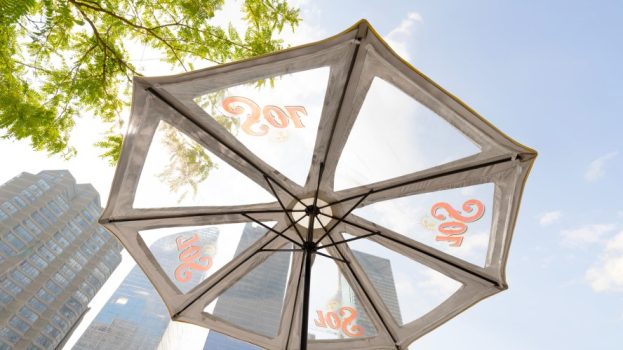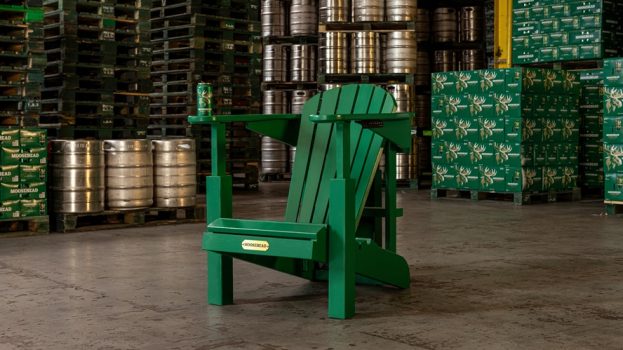[iframe_youtube video = “B7skAyWD2bI”]
Most days Lilian walked “mostly uphill” to get her usual Tim Hortons order (a large coffee with double cream), with one local questioning why the elderly lady doesn’t just make her cup of Joe at home?
Good question. But as Lilian, accessorizing her cane with a candy-apple red coat and jaunty hat, said: “In this life some things are worth the effort.”

 The emotionally stirring 1997 ad above, replete with soft instrumentals and sun-dappled shots of Lunenburg, N.S., became the first of many in Tim Hortons’ “True Stories” TV ads that pulled at the heartstrings of Canadians from coast-to-coast. Telling a compelling story that makes viewers feel something is as important in 2018 as it was more than 20 years ago, when the ad based on the true story of Lilian first ran on national TV, say Bill Moir, Tim Hortons’ former CMO (pictured, top right), and Paul Wales, previously of the QSR’s ad agency J. Walter Thompson Canada (pictured, bottom right).
The emotionally stirring 1997 ad above, replete with soft instrumentals and sun-dappled shots of Lunenburg, N.S., became the first of many in Tim Hortons’ “True Stories” TV ads that pulled at the heartstrings of Canadians from coast-to-coast. Telling a compelling story that makes viewers feel something is as important in 2018 as it was more than 20 years ago, when the ad based on the true story of Lilian first ran on national TV, say Bill Moir, Tim Hortons’ former CMO (pictured, top right), and Paul Wales, previously of the QSR’s ad agency J. Walter Thompson Canada (pictured, bottom right).
“We specialize in moving audiences and building brands through visual storytelling… Bill and I always believed the most powerful way to connect with consumers was through brand stories, and our biggest reactions, particularly with Tim Hortons, were always [via telling] brand stories,” says Wales, who worked in various capacities at JWT, where he worked from 1996 until 2014 (when he was EVP/ECD).
The “True Stories” ads were the result of a long-term partnership between the Canadian-born QSR and the Canadian arm of JWT. Two of the brains behind Tim Hortons’ winning ad strategy (starting in the ’90s) both left their respective employers in 2014 and have since started a new partnership: Upstream.
Founded in 2016, the Queen Street East startup dubs itself a “video creation company.” The East Toronto company now has seven staff, including Chris Hopper, who joined as managing partner in early 2017, and boasts a few big-name clients such as Swiss Chalet.
These days, the duo is still aiming to evoke an emotion from viewers, though its latest creative endeavor aims to hit the funny bone, not the heart.
In a bid to show off the nascent company’s storytelling chops, Moir, now the senior brand strategist at Upstream, and Wales, director of creation, cooked up a creative idea over a few pints of beer. The result? A fictional craft brewery that is brought to life through visual storytelling. A trio of 45-second spots all feature the totally made-up story of Bavarian brewmaster Johan Asche and the resulting Asche Brewery. The ads all lead up to punchlines that take advantage of the fact the Asche sounds uncannily close to a-not-so-polite word for buttocks. Upstream recently started a Kickstarter campaign that, if it reaches its goal, could turn the fictional brewery into a reality.
[iframe_vimeo video = “258838827”]
All of this may seem like quite the departure for Moir, who worked at Tim’s for almost a quarter century (and was CMO when he left), but he insists it’s not.
Back when he started at the QSR in 1990, Tim Hortons rarely used TV ads, but by the time he left in 2014 the brand had vastly expanded its TV efforts to a 52-weeks-a-year buy, he told strategy back then. During his tenure, the coffee chain grew into the leading QSR in Canada both in terms of sales and loyalty. That growth was thanks, in part, to its “True Stories” campaigns, which started with the spot about Lilian and went on to highlight other heartwarming true tales, such as the spot featuring Sammi the Golden Retriever getting coffee for his owner Larry in Saint John, N.B.
Then, as now, telling a great story (whether it’s of a cute dog carrying coffee or of a fake brewery with endless pun possibilities) is still key. We may have shifted from “The Age of TV” to “The Age of the Smartphone,” but it’s the message, not the medium, that still really counts.
[iframe_vimeo video = “258838863”]
“I think people, no matter the demographic, are still interested in watching things that interest them. So no matter the platform, [if] you put out an the idea [that’s] smart and captivating then people will connect with it,” says Wales. “It’s always the power of that video, that piece of content. While people are exposed to way more things… they’ll still share things that have captivated and moved them.”
Moir concurs.
“One school of thought is that the era of great creativity is waning and I think perhaps it’s driven by what’s happening with technology. But great creative will still work no matter which medium it’s on,” says Moir. “Brands have a functional piece of them, but really great brands have an emotional piece as well, and I think it’s tapping into that emotional piece that’s the secret and we’ve done that before. We can do it through Asche Brewery in a different way, you know? It’s still, it’s engaging, it’s entertaining – all the things that people are looking for, right? So that’s the goal.”























